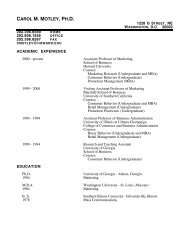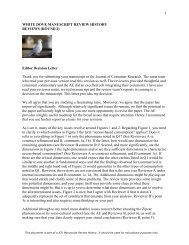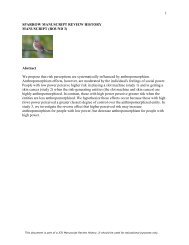Why Happiness Helps You See the Big Picture - Journal of ...
Why Happiness Helps You See the Big Picture - Journal of ...
Why Happiness Helps You See the Big Picture - Journal of ...
You also want an ePaper? Increase the reach of your titles
YUMPU automatically turns print PDFs into web optimized ePapers that Google loves.
Copyright <strong>Journal</strong> <strong>of</strong> Consumer Research 2008.<br />
Preprint (not formatted or copyedited).<br />
Do not quote or cite without permission.<br />
14<br />
that if participants were cued with general academic goals, those in a positive mood were<br />
more likely to study (M positive = 4.94 vs. M negative = 3.50; t(62) = 2.49, p < .05) than those in<br />
a negative mood. However, if participants were cued with general friendship goals, those<br />
in a positive (vs. negative) mood were less likely to study (M positive = 3.22 vs. M negative =<br />
4.13; t(62) = 2.34, p < .05).<br />
Mediation analysis. Choice was moderated by type <strong>of</strong> goal that was cued among<br />
participants. Therefore, we conducted two separate mediation analyses, one for<br />
participants cued with general academic goals and one for participants cued with general<br />
friendship goals. Among participants cued with general academic goals, regression<br />
analysis revealed a significant effect <strong>of</strong> mood on choice (b = .72, se = .29; t = 2.49, p <<br />
.05), <strong>of</strong> mood on construal (b = .18, SE = .08; t = 2.79, p < .05), and <strong>of</strong> construal on<br />
choice (b = 1.79, SE = .58; t = 3.07, p < .01). When we regressed mood on choice and<br />
controlled for level <strong>of</strong> construal, <strong>the</strong> effect <strong>of</strong> mood on choice became nonsignificant (b =<br />
.48, SE = .28; t = 1.71, p = .10), and a main effect <strong>of</strong> construal emerged (b = 1.45, SE =<br />
.60; t = 2.39, p < .03). Thus, among participants cued with academic goals, a positive<br />
mood increased abstract construal and choice <strong>of</strong> studying over friendship, but <strong>the</strong> effect<br />
<strong>of</strong> mood on choice <strong>of</strong> studying was mediated by construal level (Sobel z = 1.65, p < .05).<br />
Among participants cued with general friendship goals, regression analysis<br />
revealed a significant effect <strong>of</strong> mood on choice (b = –.45, SE = .19; t = –2.34, p < .05), <strong>of</strong><br />
mood on construal (b = .18, SE = .07; t = 2.53, p < .05), and <strong>of</strong> construal on choice (b = –<br />
1.15, SE = .39; t = –2.93, p < .01). When we regressed mood on choice and controlled for<br />
level <strong>of</strong> construal, <strong>the</strong> effect <strong>of</strong> mood on choice became nonsignificant (b = –.28, SE =<br />
.20; t = –1.45, p > .15), and a main effect <strong>of</strong> construal emerged (b = –.93, SE = .42; t = –<br />
2.22, p < .03). Thus, among participants cued with general friendship goals, a positive<br />
mood increased abstract construal and choice <strong>of</strong> friendship over studying, but <strong>the</strong> effect<br />
<strong>of</strong> mood on choice <strong>of</strong> friendship was mediated by construal level (Sobel z = 1.68, p <<br />
.05). Thus, <strong>the</strong>se data reveal that mood influences construal level and that choice <strong>of</strong><br />
abstract goals is determined by level <strong>of</strong> construal. Additional ANOVAs on questions<br />
pertaining to <strong>the</strong> scenario and attention participants paid to reading and thinking about <strong>the</strong><br />
scenario did not reveal any significant effects.<br />
Critics might suggest that participants in a positive (vs. negative) mood thought <strong>of</strong><br />
more positive reasons to follow <strong>the</strong> primed goal; however, <strong>the</strong> goal-endorsement task<br />
occurred before mood induction, making such a possibility less likely. In addition, level<br />
<strong>of</strong> construal mediated choice. As a set, <strong>the</strong>se data suggest that participants in a positive<br />
mood engaged in whatever abstract goal was accessible. They also disengaged from goals<br />
that conflicted with <strong>the</strong> currently accessible abstract goal.<br />
We must note two additional points. First, participants were specifically asked to<br />
imagine <strong>the</strong>mselves in <strong>the</strong> scenario as Jack and thus it is likely that <strong>the</strong>y applied <strong>the</strong>ir<br />
personal goals to <strong>the</strong> decision. It is possible that if participants were not asked to imagine<br />
<strong>the</strong>mselves as Jack, <strong>the</strong>y may not have applied <strong>the</strong>ir personal standards to judging o<strong>the</strong>rs.<br />
Second, in <strong>the</strong> priming task, participants endorsed general goals, and <strong>the</strong> task was titled<br />
―General Questions Survey.‖ The use <strong>of</strong> this term might have associated abstractness<br />
with <strong>the</strong> goals being endorsed, and we expect that titling <strong>the</strong> survey as ―Immediate‖ or<br />
―Specific‖ would not lead to similar effects. These are both areas for fur<strong>the</strong>r research.









